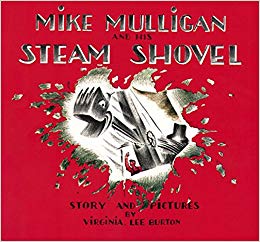Mike Mulligan and His Steam Shovel
Listen to the Recess! Clip
| Author | John Cech |
| Air Date | 10/6/1999 |

Mike Mulligan Transcript
I am standing at a part of the Big Dig near the Haymarket in Downtown Boston where they’re rebuilding a major link in the interstate highway system underground, something that might even be beyond the power of those champion diggers, Mike Mulligan and his steam shovel, Mary Anne. There’s going to be a lot of celebrating in the area next month when the city declares November 13th Mike Mulligan Day, and Houghton Mifflin, the revered publishing and and a host of area libraries will be throwing birthday parties in honor of Virginia Lee Burton’s classic picture book, which is sixty years old this fall. We thought we’d let you know early, just in case you want to go.
Virginia Lee Burton was born and raised in the Boston area. Her father was the first dean at M. I. T. and her mother a musician and poet. She studied art and dance in California and returned East in her early twenties. When she was 21, she married the sculptor George Demetrios, and together they were part of the artistic community of Cape Ann, near Gloucester, Massachusetts, where she was the guiding spirit of the Folly Cove Designers, an arts and crafts movement, famed for its textiles.
The Folly Cove designs, with their strong, swirling, folkloric patterns found their way into Virginia Lee Burton’s children’s books — especially works like The Little House, Life Story, and Mike Mulligan, which Ms. Burton dedicated to her son Michael, who was four at the time. He is the little blonde boy in the book who comes to the rescue of the adults and finds the answer to the problem that is puzzling everyone at the end of the book — how to get Mike Mulligan and his steam shovel out of the perfect hole they have dug for the foundation of Popperville’s new town hall.
No wonder this fable about how personal pluck and determination can beat the odds (and new-fangled technology) has stayed around for six decades — we all have a soft spot for the underdog, a national quality that was brought into sharp definition during the Great Depression of the 1930s when this book first appeared. And there is something else about this book that echoes that time, of Busby Berkely and Astaire and Rogers — boy, can Ms. Burton’s pictures dance, casting in their wake triumphant clouds of steam and grace, of joyful work and bright, clear energy.